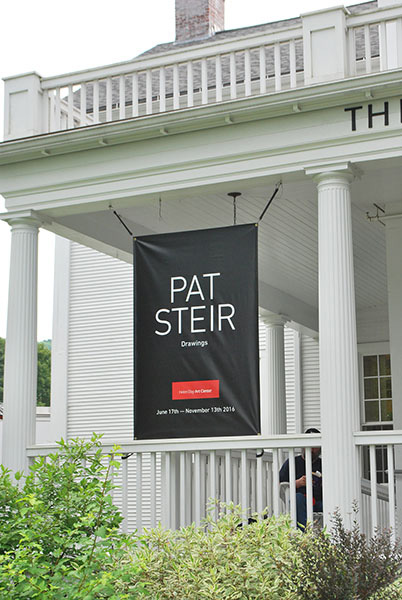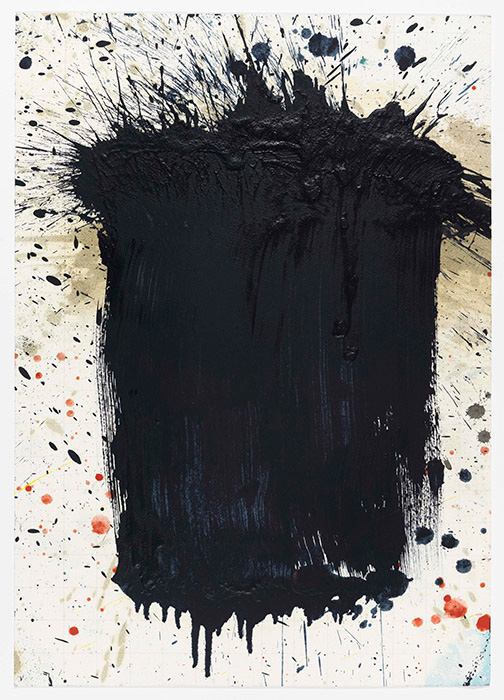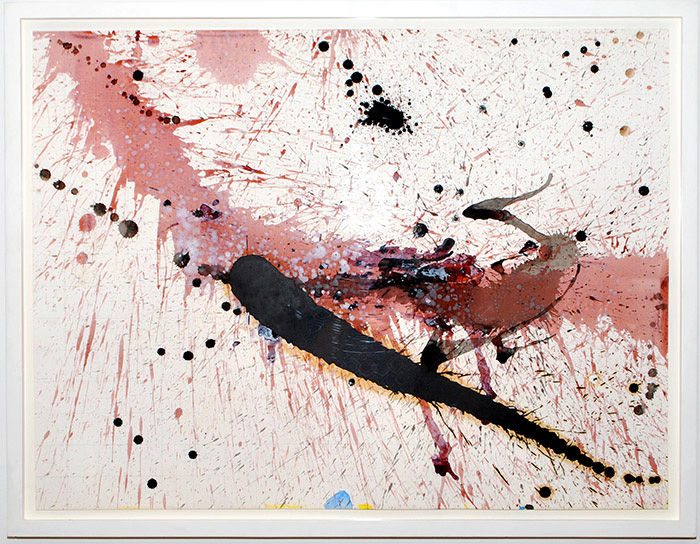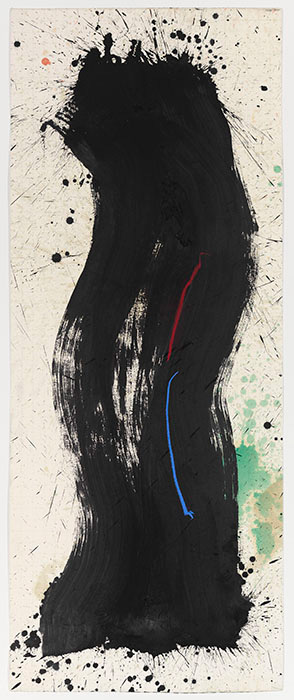| World-Class Artist Pat Steir Exhibits in Stowe | |||
| by Cynthia Close | |||
|
|||
Steir's paintings require galleries with ceilings greater than 14 feet, which the Helen Day could not accommodate, so in negotiating what the artist would or could show, it was agreed that smaller works, identified by Steir as "drawings," seemed most appropriate. Perhaps modest by New York standards, this show accomplishes one of the primary mandates of the Helen Day: introducing new audiences to challenging work by a major figure in contemporary art.
In the main gallery, a suite of untitled works on paper done in the last decade is pinned directly to the white walls. Not drawings in the traditional sense, they are actually painterly mixed media works, visually related by a powerful black swath of paint that occupies the center of each piece, as though obliterating something underneath that the artist does not want us to see. These works harkened back to Steir's early conversion from a career as an illustrator making figurative art when she slashed X's through her more recognizable imagery. In explaining this transition, Steir stated, "I wanted to destroy images as symbols. To make the image a symbol for a symbol. I had to act it out―make the image and cross it out." These works on paper are informally pinned to the wall, making them seem vulnerable and simultaneously more accessible to the viewer. We have no frame or glass to keep us at a distance from the artist's intent, her gesture. Rachel Moore's decision to leave out those often ubiquitous cue cards on the walls telling us what we should know about how to "read" an artwork also puts the onus on the viewers, encouraging us to look at these drawings on our own terms. |
|||
|
|||
Her slow, meditative observation of the downward flow of poured paint demonstrates the influence of Taoist philosophy on her methods, producing works that embody harmony between man and nature like her well-known and ongoing Waterfall series.
|
|||
Pat Steir |
|||
| As we enter the adjoining East Gallery at Helen Day, we encounter more traditionally presented white-framed work. Rather than projecting their energy outward, the pieces here dating from 2004–2008 are more nuanced, more colorful and have a delicacy that invites us in to examine the forms as they interact with the negative space. The earliest work in the show titled Drum Series (1977) is hung by itself near the entrance. Of all the pieces on display, it comes closest to the definition of drawing in that the medium is graphite or pencil marks, with lines and symbols on sheets of paper, lined up in twos, inside a single frame. Like finding some long lost hieroglyphics, if we can decode it, perhaps it holds the keys to knowing more about the body of work that followed. | |||
Pat Steir |
Born in 1940 (although some sources list 1938) in Newark, New Jersey, this enigmatic artist is known to us through her art, rather than through the cult of personality surrounding some of her precursors like Pollack or Mark Rothko, both who had dramatic and untimely deaths. In Molly Davies's video, we see Steir in motion, hauling buckets of paint, climbing scaffolding, belying her 76 years. Her sly humor also comes through when she mugs a bit self-consciously for the camera, as art, produced in contemplation like Steir's, is not usually a spectator sport. There is also a funny bit shot outside the studio on the streets and in the hallowed art institutions of New York City. We follow Steir through the galleries of the Metropolitan Museum of Art and MOMA, where she comments on some of the work, admiring, in particular, the color field paintings of Clifford Still. Then she spies one of her own large works, hanging over the reception and ticket area in MOMA. She asks if she or her friend can take a picture, and it appears as though the staff behind the counter tells her no picture taking allowed. She attempts to explain that she is the artist, but it seems doubtful that they believe her. She smiles and shrugs, and she, along with her videographer, move on. Pat Steir is undaunted by the challenges that naturally come as we age. At one point she says, "I love it when [painting] is impossible, when it's hard. Otherwise, why do it? Why do anything?" Luckily the results of her lifelong labor provide the answer. |
||
|
Cynthia Close is a contributing editor for Documentary Magazine, art editor for the literary journal Mud Season Review, and an advisor to the Vermont International Film Festival. She lives in Burlington, Vermont, with her doggie, Ethel.
|
||



